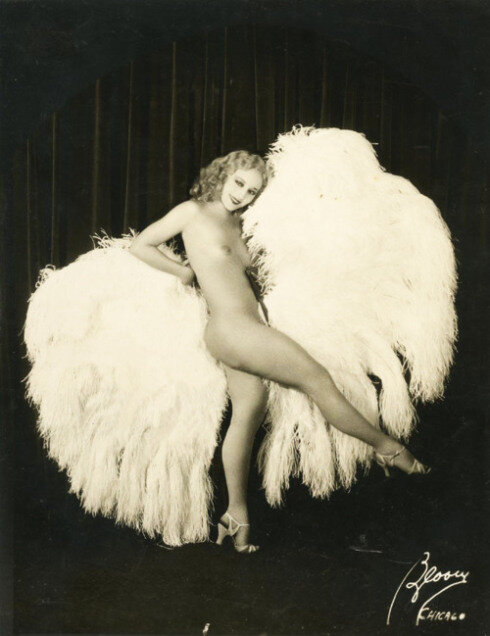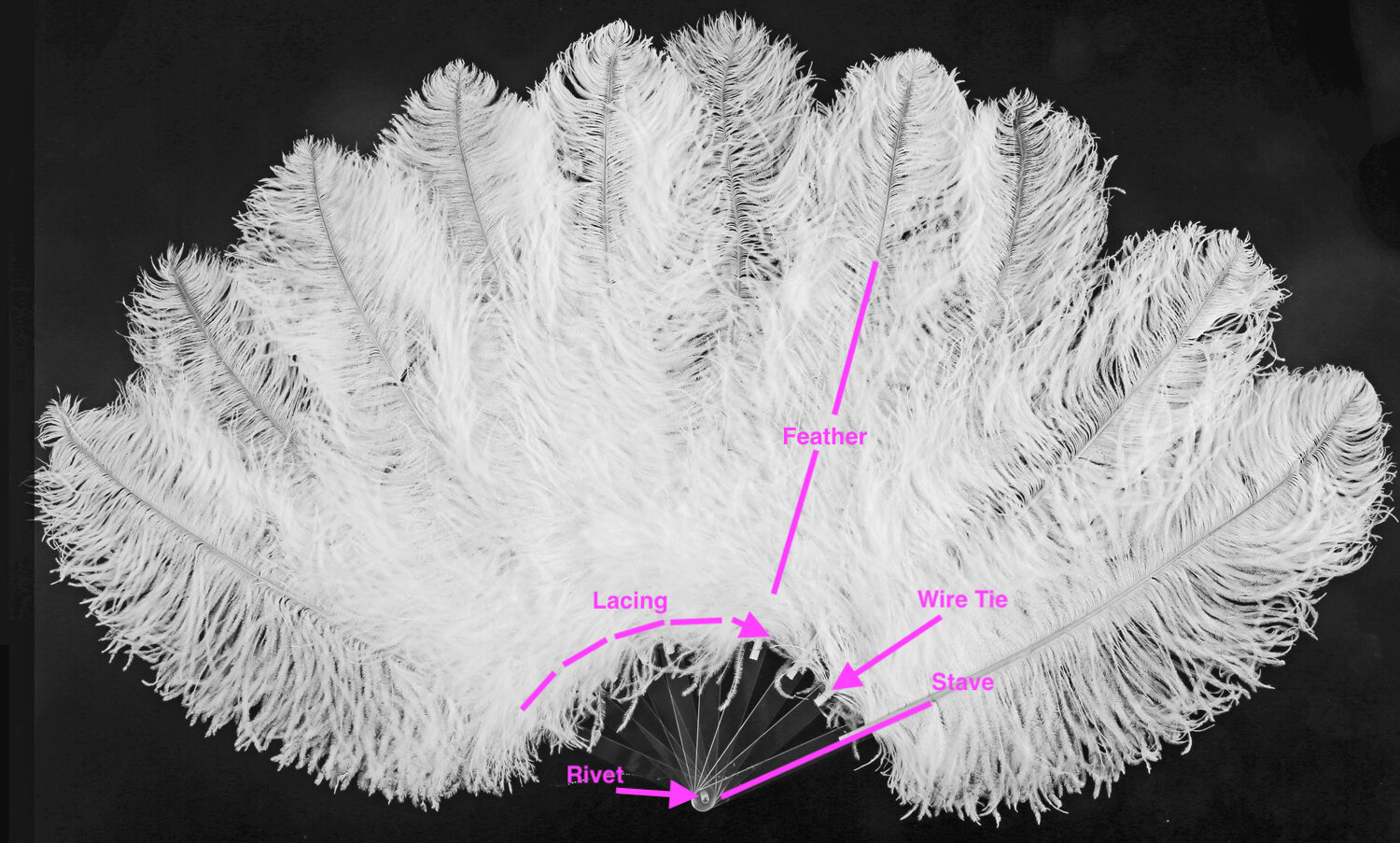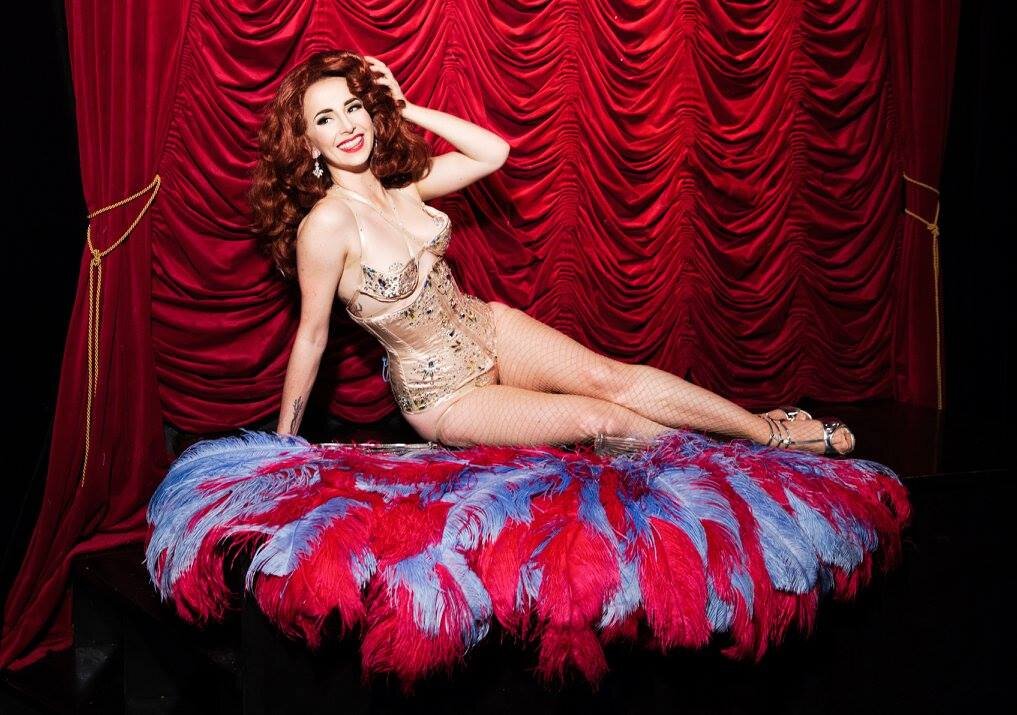The History of the Feather Fan
Written by Maple Rose
In steamy, humid countries - a breeze through the leaves brings temporary relief to one's sticky skin. Travel back thousands of years and some switched on chum realised a large leaf could be plucked, held and ruffled to billow onto oneself and mimic a satisfying breeze.
However, as any practical item does, the humble fan became a decorative accessory throughout history. With 3 different types of fans invented (the flat fan, the feather fan and the folding fan), anyone with the materials available to them could provide themselves relief from the heat or fashion themselves an object that defines sophistication.
Ostrich feather fans have a long history of serving as objects of prestige. King Tut hunted ostriches for their feathers which were made into the huge royal fans (flabella) wielded by slaves that followed him in his convoy. Camel caravans carried the plumes of wild ostriches captured south of the Sahara Desert to the merchants in North Africa for shipment to Europe, and the fashionable item continued to be seen as an item of prestige for centuries.
Elizabeth I is renowned for owning a collection of ostrich feather fans. She said that ‘such a fan was the only suitable gift for a queen.’ Italy was renowned for dying ostrich feathers into all fashionable colours and introduced the italian fashion of fans to the French, who became the ostrich feather fan powerhouse of production. The folding fan base (staves) began to be used by the sixteenth century. These were either ivory, wood or even metal! By the seventeenth century wealthy commoners as well as royals owned these luxury items, however the folding paper fan (which was easier to manufacture and source materials) became more popular with the masses.
In the late nineteenth century, American women began to bring the newest fashions from Paris and London to the states, which included the glamorous ostrich feather fan. From the 1880s to 1910, department stores across the states advertised feather fans for sale and it became a year round accessory. Primarily used a mark of wealth, they could be as expensive as a lady's jewels. The fashion became so popular that by 1900 plumes from wild ostriches were replaced by feathers harvested from birds raised on ranches in South Africa, California and Australia.
The booming trade in ostrich feathers halted in 1914 when WWI began, and new laws intended to protect wildfowl affected both the ostrich trade and fashion by restricting the use of feathers. Styles were changing - ostrich feathers lost most of their decorative appeal when huge hats (needed to support the large plumes) were replaced by more practical, smaller styles. It was primarily the invention of the motor car that brought the Ostrich Feather Boom Era to an end. Faster open vehicles played havoc with the ladies’ splendid feather decorated fashions.
The “flapper” is noted for bringing back the ostrich plume. In 1919 Zelda Fitzgerald carried a fan at her wedding, which inspired many of the elite ladies to follow suit. The war was over! It was a time to celebrate and dress flamboyantly once more. Skirts came up, beads and feathers were used to enhance one's dance moves, and the roaring 20s took feather boas to new heights!
Sally Rand
The feather fan began to take a risque turn! Burlesque and carnival performers used the large props to reveal and conceal their nearly naked (or sometimes completely naked) bodies as they moved seductively. At the 1933 Chicago World Fair, Sally Rand debuted her infamous “Fan Dance.” She played peak-a-boo with the audience as she flounced and twirled her giant white plumed fans to the tune of “Claire de Lune.” Sally quickly climbed to stardom and is known as the figurehead of feather fan dancing. She danced until she retired well into her seventies.
However, Sally wasn’t the first naked starlet to play hide-and-seek with the audience. Many other performers during the 1920s used this theatrical device to their advantage, including the actress and burlesque performer Faith Bacon. Bacon began her career in Paris and returned to the states in the later part of the decade. In July 1930, she appeared as a "principal nude" in the production of the Earl Carroll's Vanities, a show that was continuously raided and performers were arrested for indecency. Faith’s act survived a number of refurbishments including a chiffon garment to hide her lady bits. Following her performance in the Earl Carroll’s Vanities, She performed her fan dance in the Ziegfeld Follies in 1931.
Faith Bacon in Earl Carroll’s Vanities
In 1933, she went to the Chicago World's Fair after learning that a rival dancer, Sally Rand was also performing a fan dance. Bacon, who maintained she originated the dance for Earl Carroll in 1930, billed herself as “The Original Fan Dancer.” In October 1938, Bacon sued dancer Sally Rand for $375,000 in damages and sought an injunction barring her from doing the fan dance which Bacon still maintained that she originated. Bacon accused Rand of stealing the dance. Rand denied Bacon's accusations, claiming jealousy and stated, "The fan idea is as old as Cleopatra. She can't sue me for that.”
Since the 1930s the Feather fan has been synonymous with art of Burlesque. Many performers have taken inspiration from the greats and experiment with different types of feathers and shapes. You will see the traditional plumed feather fan, the boa or “waterfall” feather fan”, the peacock feather fan, the pheasant feather fan, and even vegan fans made from ingenious materials to mimic the idea of feathers! In the 2009, the famous performer Catherine D’Lish debuted her “World’s Largest Feather Fans” act at the first annual New Orleans Burlesque Festival.
One element remains the same throughout history - the feather fan is a prop of sophistication and creates a sensual feeling of luxury and glamour. Wield with love, and the feathers will love you back.
The construction of the feather fan hasn’t changed much since the sixteenth century. Most fans are built upon 12 folding staves. These can either be bamboo, perspex (acrylic) or aluminium. Each material has its benefits, and performers begin to prefer one or the other as they practice with their fans.
The construction of a fan is simple - the feather is attached to a stave using a wire tie. Once all twelve staves are assembled, they are riveted together at the bottom and laced through the middle to keep them from breaking apart. The size of the fan usually depends on the size of the feather and the strength of the stave.
There are some amazing feather fan makers right here in Australia! Maison Burlesque has an affiliation with both Fantastique Feather Creations and Sterling Staves who both manufacture their own perspex staves and build professional burlesque feather fans. However, you can make them yourself! Poppy Cherry, our headmistress, runs a fan making workshop about twice a year at Maison Burlesque so you can construct your very own custom made pair of fans!
Stave by Fantastique Feather Creations
Stave by Sterling Staves
Don’t have a set of feather fans, nor have the time or money to make a professional set? Then you can make your own VEGAN fan with the help of Maple Rose on our YouTube Channel, The Humble Sequin.
Feather Fan dancing is a beautiful art form to learn with each instructor incorporating their own style to the apparatus. You can learn feather fan dancing from our in-house fan dance instructors, Poppy Cherry and Maple Rose! With beginner classes right through to advanced, we cater to all levels of fan dancing. You can see what courses we have coming up at our classes page.
Sources:
Clark, D., Clark, D. and profile, V., 2020. Ostrich Feathers In Fashion. [online] Debyclark.blogspot.com. Available at: <http://debyclark.blogspot.com/2012/11/ostrich-feathers-in-fashion.html > [Accessed 13 April 2020].
En.wikipedia.org. 2020. Faith Bacon. [online] Available at: <https://en.wikipedia.org/wiki/Faith_Bacon >
[Accessed 13 April 2020].
Collections.mnhs.org. 2020. [online] Available at: <http://collections.mnhs.org/MNHistoryMagazine/articles/64/v64i04p136-147.pdf >
[Accessed 13 April 2020].
En.wikipedia.org. 2020. Sally Rand. [online] Available at: <https://en.wikipedia.org/wiki/Sally_Rand >
[Accessed 13 April 2020].











